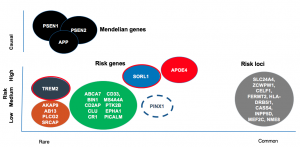Content:
At one end of the Alzheimer’s disease genetic spectrum lie the catastrophic mutations in APP and presenilin that lead to autosomal-dominant, early onset AD. At the other end are dozens of common variants that each contribute a smidgen to a person’s risk of late-onset AD. Between the two ends lie rare variants—glitches in the DNA that appear less frequently than common variants, but pack a punch when they do appear. The Alzheimer’s Association International Meeting, held July 14-18, 2019 in Los Angeles, California, featured new rare variants. They came out of the whole-genome and whole-exome sequencing projects geneticists are currently focusing on, and from a deep dive into existing GWAS data. Other newly published work identifies two new risk genes near the ApoE locus. Both contribute to AD risk independent of ApoE, and they may help explain variations in risk seen with the ApoE4 allele in different ethnic groups (see below and Part 5 of this series).


